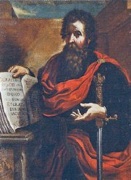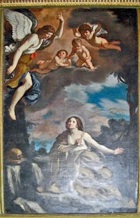
Self-portrait (ca. 1635)
Musée du Louvre, Paris
Giovanni Francesco Barbieri, who was known as il Guercino because of his squint, was born in Cento, a town near Bologna, and had moved to that city by 1615. He worked in Rome in Rome in 1621-3 for the Bolognese Pope Gregory XV. He was a prolific artist, and many of his works survive.
Perugia
SS Peter and Paul (17th century)


These panels, which are attributed to il Guercino are in the right aisle of San Pietro.
Spoleto
St Mary Magdalene (17th century)

Terni
Resurrection of Lazarus (17th century)
This panel in the Museo Diocesano is attributed to il Guercino.



